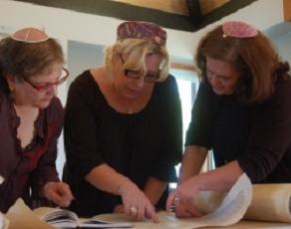|
World Jewish News

Torah scribes Linda Coppleson, Rabbi Chana Klebansky and Rachel Reichhardt, l-r, discuss the placement of text on a panel before it is sewn onto the rest of the scroll, Oct. 13, 2010 in Seattle. (Joel Magalnick, JTA)
|
Female scribes finish writing Torah scroll
19.10.2010, Religion It took seven years to write and just a few days to sew together, but on Oct. 15 the first Torah scroll written entirely by a group of women was attached to its wooden poles and declared complete.
The ceremony was held at Seattle’s Kadima Reconstructionist Community, which sponsored the project.
“We had the idea 10 years ago, but when we looked around for women scribes, we realized there weren’t any,” said Kadima member Wendy Graff, one of the volunteers who shepherded the project from its inception.
To remedy the dilemma, Kadima supported two women as they trained to be scribes. Four others trained on their own. Ultimately the six female scribes, or sofrot, worked on the scroll in four countries: two in Israel, two in the United States, and one each in Brazil and Canada.
The panels were checked by experts in Jerusalem and New York, who made the minor tikkunim, or corrections, permitted by Jewish law. Major errors require a complete redo of the page.
Last week the panels were flown to Seattle, where another group of women sewed them together. The Torah mantle, including wooden poles, or atzei chayim, and other traditional accoutrements were created by seven local artists.
The scribes were paid, but the others who worked on the project donated their time.
According to Orthodox tradition, women are not permitted to be Torah scribes.
Over the last decade, however, a handful of women have trained as scribes. It’s an exacting process. Torahs must be written by hand on parchment made from the skins of kosher animals, and scribes must state their intentions out loud each time they prepare to write God’s name.
In September 2007, Jen Taylor Friedman of New York completed the first Torah scroll known to have been written by a woman, for the United Hebrew Congregation of St. Louis, Mo.
Friedman advised the Women’s Torah Project and was one of the experts who checked for small errors. She is among a number of women at work on other Torah scrolls, including Julie Seltzer of San Francisco, one of the six scribes on the Seattle project.
Seltzer wrote four of the Seattle Torah’s 62 panels in the summer of 2009, when she was living in New York. Since October 2009, she has been writing a Torah scroll at the Contemporary Jewish Museum in San Francisco as part of the yearlong exhibition, “As it is Written: Project 304,805.”
Seltzer began the year doing all her writing in public at the museum, so visitors could watch and ask questions. She soon realized, however, that she would never complete the scroll by her December 2010 deadline, so Seltzer writes mainly at home now and spends several days a week at the museum talking to the public.
“Jewish learning and text was my entryway to Jewish practice and spirituality, and continues to be one of the primary ways I connect,” Seltzer told JTA, saying she feels honored to be able to write a Torah scroll. “To be this close to the text, on the elemental level of the letters, is extraordinary.”
Seltzer says she doesn’t feel that her experience writing a Torah is any different from a male scribe. But the fact that her Torah, and the one completed by the Women’s Torah Project, were written by women means they will not be accepted for use in Orthodox congregations.
On her website, Hasoferet.com, Friedman tells female scribes they need to be upfront about that when they are commissioned to work on a Torah.
“Why is a soferet like a swordfish?” she writes. Swordfish, she says, is not considered kosher by most Orthodox Jews, although Conservative Jews will eat it.
“If I repair a Torah and then let Orthodox congregations use it,” she wrote, it’s “an appalling desecration of trust. If we want respect, as Jews or as human beings, we have to give respect, and part of that is accepting that other Jews' rule systems are valid despite being different from ours.”
By Sue Fishkoff
JTA
|
|
